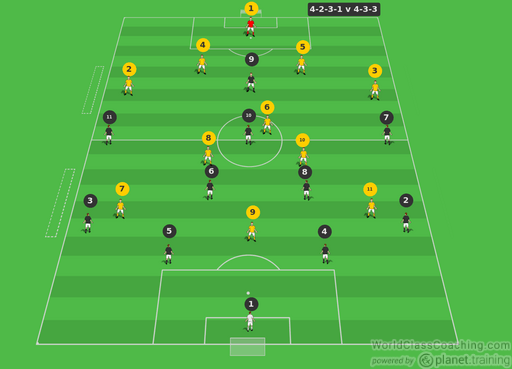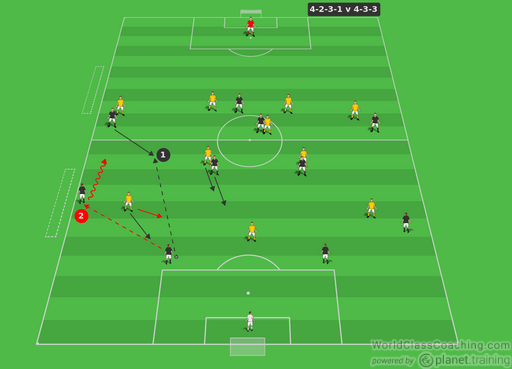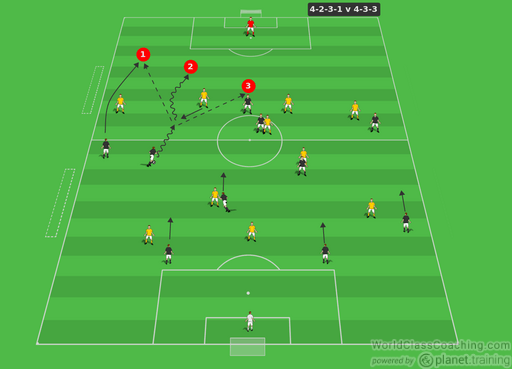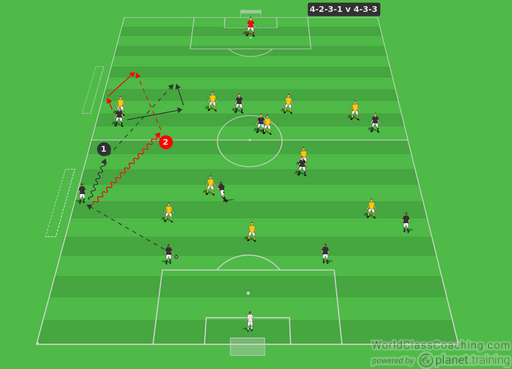By Sean Pearson
With the new USSF mandated birth year and small sided games changes there is a lot of trial and error regarding formations and systems of play. Instead of 8v8 formations, as coaches, we are now trying to figure out how to position our players in the new 7 v 7 and 9 v 9 formations. Some clubs have an academy structure where all teams must play the same formation, others allow coaches to choose what works for their team because players in each team have different attributes.
In these Systems of Play articles, I aim to address a wide range of 7 v 7, 9 v 9 and 11 v 11 formations and ways in which to use your players to your advantage.
Formation
The 4-2-3-1 like the 4-3-3 has 2 players on the wings. The reason I have chosen the 4-2-3-1 to concentrate on is the starting positions of the wide players is closer than the 4-3-3, however with the job of the modern day full back to get forward as much as possible it might not even matter, but for those coaches who do not have the best athletes the 4-2-3-1 allows those wide players to be more connected.

Role of the Wide Players in the 4-2-3-1
When playing out from the back in the 4-2-3-1 you want to give your CB as many options as possible. These need to be quick decisive movement to allow the CB to make a quick decision. Depending on the type of movement and position the attacking wide striker is in there are different options. (1) If the striker presses and blocks off the wide pass then winger needs to drop down and in, into the space. (2) if the striker aims to stops this pass then the FB needs to be available out wide behind the line of the striker so they can advance forward quicker. In both instances the CM on the side of the ball drops down.

The reason for the CM dropping down is important. When the winger receives the ball, if there is pressure from the FB then the winger sets the ball into the space. The CM, after running down turns behind the player marking them, at the same time the FB runs into the space. The CM then passes into the space through the gap of the FB and CB.
If the FB does not follow the winger, they should turn and begin to drive towards the CB. From there, there are 3 options to go forward to get directly behind the last line. (1) play wide to the FB, who has overlapped the opposition FB. (2) Take on the CB 1v1 (3) after committing the CB slide the striker in.

When the FB receives the ball from the CB they have 2 options. The option they take directly relates to the movement of the winger. (1) If the FB drives with the ball straight up the field the winger should come inside. The reason for this is to aim to create a 2v1 on the opposition FB. Draw the FB in and slide the winger in behind the defense. (2) If the FB decides to drive inside, as there is plenty of space, then the winger stays wide, again to isolate the opposition FB in a 2v1. (3) Another option could be for the FB and winger to play a give and go around the FB, either way with your FB running inside or down the line.

What your FB and winger need to realize is they are connected, they are a unit. One player’s movement relates to the others and they should work together to manipulate the opposition FB. If both players stay on the line when attacking, their options of moving the ball forwards would be limited.
Remember if this is no the scenario you see from the opposition then this is not the strategy you use, they are plenty of other strategies to manipulate the other team’s players. However if you are using another strategy and the opposition players then try to stop it and this way of attacking becomes available, coach up your players to understand when and where they are able to use it.
By Sean Pearson. Sean is also the author Coaching Team Shape in the 3-3-1, Coaching Team Shape in the 4-2-3-1 and Coaching Team Shape in the 4-3-3


